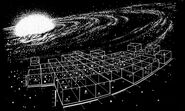(covers information from several alternate timelines)
The Vulcan system was an inhabited star system located in the Alpha Quadrant. The system consisted of a primary star, 40 Eridani A, and several planets, including Delta Vega and Vulcan. Neighboring the Andorian system, it was located sixteen light years from the Sol system. (ENT: "The Andorian Incident", "Home", "Daedalus"; Star Trek; DIS: "Magic to Make the Sanest Man Go Mad")

Alpha/Beta Quadrant Overview
In 2256, Vulcan was labeled on the star chart "Alpha/Beta Quadrant Overview" in the ready room aboard the USS Discovery. (DIS: "Magic to Make the Sanest Man Go Mad")
In 2257, during the first Federation-Klingon War, this star's system was near the front line. (DIS: "The War Without, The War Within")
In 2258, in the alternate reality, Delta Vega was the location of a Starfleet outpost. That year, Nero destroyed the planet Vulcan by creating a small black hole in its core. (Star Trek)
In 2293, the location of Vulcan in the Milky Way Galaxy was labeled in a star chart that was in Captain James T. Kirk's quarters aboard the USS Enterprise-A. (Star Trek VI: The Undiscovered Country, okudagram)
Appendices
Related topics
Appearances
Background information

T'Khut and its moon seen from the surface of Vulcan

Two other worlds in the Vulcan system seen from the surface of Vulcan
A picture of a star chart supposedly used for Star Trek: Discovery was tweeted by Ted Sullivan on November 28, 2017. According to this map, the star Vulcan was also known as 40 Eridani A. [1]
The original theatrical edit of Star Trek: The Motion Picture depicted four large orbs in the Vulcan sky. They were removed in the DVD release of Star Trek: The Motion Picture - The Director's Edition and replaced by an orange sky. According to Star Trek: Communicator issue 136, p. 27, the additional planets were removed for the reason that the scene took place during daytime, so a night sky was not appropriate, and they were elements that distracted the viewer from a scene intended to take place on a far-off monastic temple. Vulcan in and of itself was considered to be interesting enough without cluttering the sky with these planets.
According to Star Trek: Star Charts (p. 58), T'Khut was the name of Vulcan's twin planet that was visible from the planet's surface. T'Khut was classified as a G-class world, and had one moon. The Vulcan system also known as the 40 Eridani A System or Omicron2 Ceti System was a trinary star system. 40 Eridani A had a spectral type of K1V with an absolute magnitude of 6.0. 40 Eridani B had a spectral type of AVII with an absolute magnitude of 11.2. 40 Eridani C had a spectral type of M4V with an absolute magnitude of 12.3. The distance between A and B was 400 au; the distance between B and C was 44 au. The orbital period of this system was 248 years.
According to the Stellar Cartography: The Starfleet Reference Library ("Stellar Cartography", pp. 22-24 & 34), the Vulcan system was the 40 Eridani A system. The 40 Eridani system was known to the Vulcans as Nevasi. The primary star, 40 Eridani A (Nevasi A), was class K. The innermost planet was a rocky class B planet named Ket-Cheleb. Vulcan (T'Khasi) was in a co-orbital relationship with the class G planet T'Khut ("the Watcher"), which had one moon named T'Rukhemai ("the Eye of the Watcher"). The icy planetoid Delta Vega was located in the outer asteroid belt. The two companions of 40 Eridani A, 40 Eridani B (Nevasi B) and 40 Eridani C (Nevasi C), were a white class A4 dwarf and a red flare class M4 dwarf, respectively.
There has been, however, no direct canonical reference of the Vulcan system being the 40 Eridani A system, although that is widely considered to be the case. In "Home" and "Daedalus", Vulcan was mentioned as being slightly over sixteen light years from Earth, the same distance between Earth and 40 Eridani A. According to text commentary by Michael and Denise Okuda for "The Forge" on the ENT Season 4 DVD, the possibility of Vulcan being located in the 40 Eridani system originated from a suggestion by novelist James Blish. When three astronomers (Sallie Baliunas, Robert Donahue, and George Nassiopoulas) who had been studying the system at Mount Wilson Observatory published a letter stating that the star "40 Eridani A could support a planet with Earth-like life" and that it would "have the Sun's brightness for a planet fifty million miles away", they theorized that Vulcan could be in orbit of this star, a theory Gene Roddenberry himself supported by signing their letter, according to Sky & Telescope, 1991 July.
Recent real-world discoveries have confirmed the likely presence of at least three planets in the Epsilon Eridani system. [2] .
External links
- 40 Eridani at Memory Beta, the wiki for licensed Star Trek works
- 40 Eridani at Wikipedia
- 40 Eridani at the Internet Stellar Database




